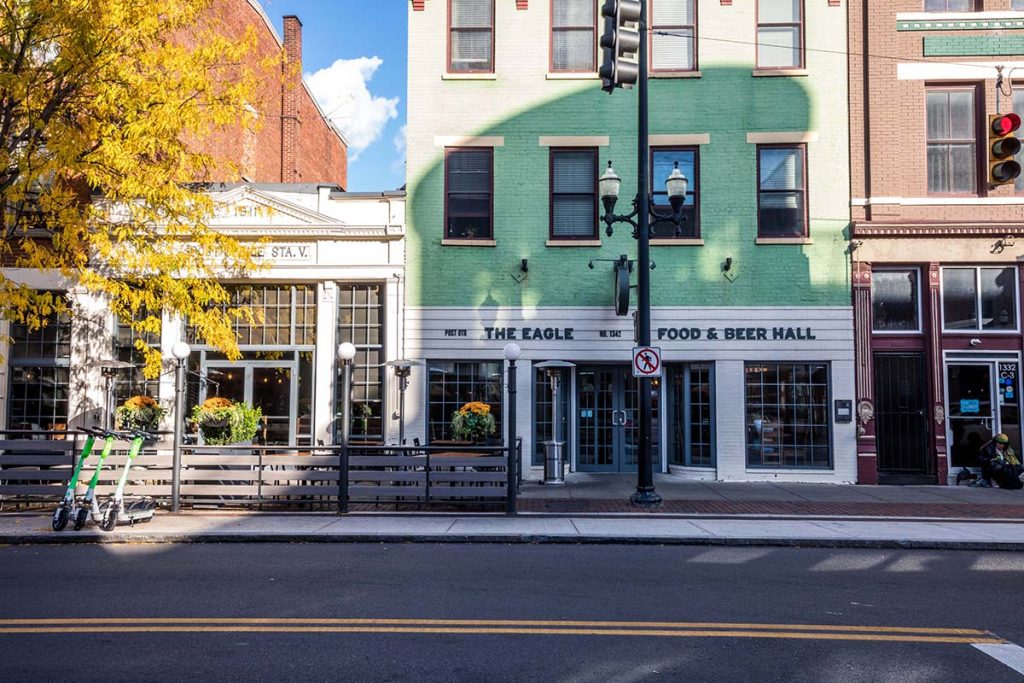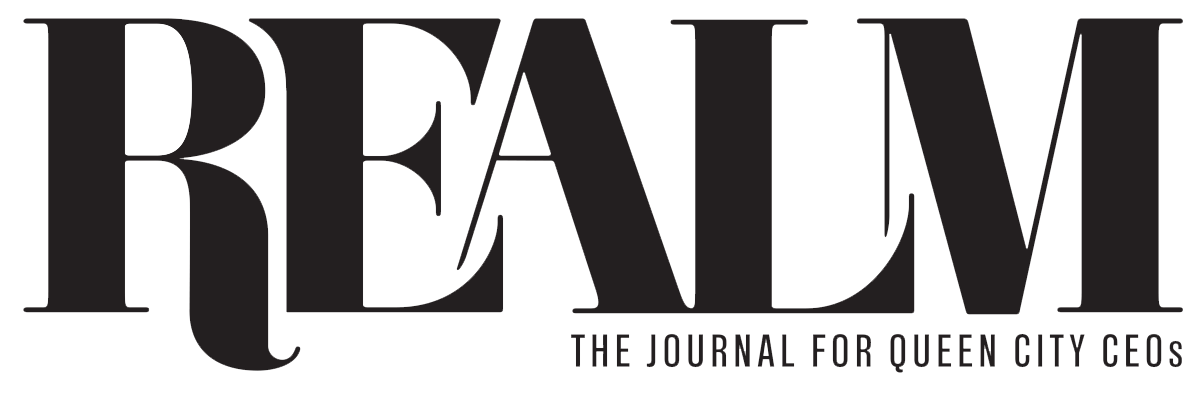A gust of wind tore through Fountain Square just before noon that day. But no one noticed, except perhaps for the pigeons, perplexed at the solitude and oblivious as to why. It was St. Patrick’s Day, but there were no revelers jamming O’Malley’s in the Alley or Arnold’s. It was also Primary Election Day 2020, but polling places were closed.
The spring breeze was almost ominous, swirling with fear, confusion, uncertainty, frustration, anxiety, isolation, and a bit of anger. Friendships had been reduced to flat screens. Zoom calls were interrupted by a crying baby or a barking dog. You sprayed your mail and Kroger grocery bags with Lysol and obsessing over Tiger King or binged on Friends reruns. You wore a mask wherever you went, if you went anywhere.

Jan-Michele Kearney was scrambling in March 2020. Soon to become the newest member of Cincinnati City Council, she’d invited 100 people to the official announcement of her appointment to complete the term of Councilmember Tamaya Dennard. But two hours before the announcement, Gov. Mike DeWine issued an executive order limiting public gatherings in Ohio to 10 people. The now-Vice Mayor realized she had calls to make. “And when I was sworn in a week later, it was just my immediate family who could attend,” she recalls. “I was sworn in and then, Here are your office keys, good luck! and I was on my own. I came to City Hall, and there was no one here. It was a ghost town.”
Just two weeks earlier, thousands of people had packed Bockfest Hall in Over-the-Rhine to enjoy the zany parade and crown a new Sausage Queen. Hamilton had just concluded its electric run at the Aronoff Center for the Arts. March Madness was coming, with Reds baseball was right around the corner. Then COVID-19 hit, and life ground to a crashing halt.
The story of the pandemic, three years later, is now also a story of collaboration, cooperation, and story’s conclusion is far from certain.
Tim Elsbrock, Fifth Third Bank’s regional president, recalls that “it was a scramble trying to figure out how we were going to do things and how we were going to work from home,” in March 2020. “There was a fragility at first as to how to do our work, but that went away in about a month. We didn’t flourish, but we were able to keep the trains running.”
While Fifth Third’s 30-story downtown skyscraper emptied out, the call center in Madisonville and most of the bank’s branch offices remained open, albeit with changes necessary to comply with social-distancing guidelines and state and local government mandates. “We had 10,000 soldiers who never left their posts,” Elsbrock says proudly. “That’s almost half of our total employees. People needed their bank branches to be open, and we were.” He laughs as we remember the days when customers came wearing a mask and that was normal.
Fifth Third was the first of Cincinnati’s major corporations to begin the process of returning to the office, motivated in large part by senior management’s desire to avoid the appearance of a caste system, where downtown employees are treated differently from the rest of the company. Just six weeks into the shutdown, the bank put out a call for volunteers: We’re going to bring 25 percent of you back. Who wants in?
“I raised my hand, because I really needed to get out of my room,” says Courtney Dulle, 24, a commercial relationship manager. This was the Xavier graduate’s first job out of college, and she readily admits she missed the human interaction of the office. “At first, I was excited about working from home. I could hang out with my dog, get my laundry done, and I figured, You know, a little change like this will keep me on my toes.”
Like most people, Dulle thought the crisis would pass quickly and things would return to normal. “Then it didn’t,” she says. “And after a couple of weeks I got tired of working, sleeping, eating, and always being in my 450-square-foot apartment. My dog liked me being home all the time, but I was getting stir crazy.”
Everything was closed. Friends were two-dimensional on her laptop. Like most, she struggled with office Zoom calls, the technology mostly working but with those annoying attributes we all came to despise: dialogue cutting out, cameras going awry or dark, having to “raise your hand” to speak, and distracting background noises. She laughs when she remembers those screen-time happy hours “when we really tried hard to keep in touch, but it just wasn’t the same.”
It wasn’t the same in the restaurant business either. Perhaps no other sector of the economy was more impacted and had to scramble more quickly than eating establishments. Particularly hard hit were the full-service spots catering to diners who want waiters, tablecloths, and silverware, not plastic forks and takeout bags delivered curbside by masked and gloved servers. “We moved to carryout as quickly as possible at first,” says Joe Lanni, co-founder and owner of the Thunderdome Restaurant Group. “But it all happened so quickly that we just weren’t ready for it. People were scared and staying home. They certainly weren’t coming out to eat.”

Thunderdome properties include popular restaurants like Pepp & Dolores, Bakersfield, Currito, The Eagle, and Maplewood. It wasn’t long, Lanni remembers, before “it hit us that, to survive, we were going to have to furlough our workers.”
Waiters and chefs can’t work from home, so the decision was as painful for Lanni as it was for every restaurant owner and employee. But layoffs weren’t enough to stop the bleeding. He still had bills to pay, debt to retire, and rent to meet, and he remembers telling his bankers and landlords to “just get me through July.” Then, as the pandemic lingered, “it was, Cover me until the kids go back to school.” But, of course, the kids didn’t go back. COVID wasn’t just a battle—it was a war.
At the 3CDC offices in Over-the-Rhine, officials wondered what the pandemic shutdown would mean for the tremendous progress the city had made in revitalizing its urban core. 3CDC had helped transformed OTR into a solid retail and entertainment district and was finalizing plans for The Foundry at Fountain Square in the old Macy’s store. Would they survive a pandemic? “We decided early on that we weren’t going to manage a decline,” says Joe Rudemiller, 3CDC’s vice president of communications and marketing. “We felt we had good momentum with the projects underway, and we believed strongly in our urban core. If we continued to move forward, things would bounce back.”
Planning continued—remotely at first—but construction at the various sites around town was only minimally impacted. The work was mostly outside in the fresh air, and it wasn’t difficult for workers to comply with the social distancing guidelines in enclosed spaces.
Rudemiller says with satisfaction that the organization’s commitment to work through the pandemic is paying off with some tenants already moved into The Foundry and more to come. “It’s putting vibrant new life back into the Fountain Square area and will have a positive impact on the whole downtown,” he says.
Like any business, 3CDC had its economic challenges even as the construction and planning continued. One of the organization’s most important sources of income, parking garage revenue, dried up as commuters stayed home. Some OTR and downtown residents park in the garages, but the majority are downtown workers and, on weekends, patrons of the city’s entertainment venues. Those revenues pay off millions of dollars in bonds that financed construction of the garages and public spaces, and they disappeared suddenly.
3CDC reworked leases, restructured debts, and used the federal government’s Payment Protection Program (PPP) funding to get them through. “We came out of it battered, but financially in decent shape compared to what it could have been,” says Rudemiller.

There were losses, he acknowledges. The Loring Group was working hard on a residential housing project at West Fourth and Plum streets when the pandemic hit, but momentum slowed and the group hasn’t returned to it. Rudemiller says 3CDC is hopeful that activity will continue to rebound, though, as the economy picks up and work begins in earnest on redeveloping and enlarging the Duke Energy Convention Center.
The pandemic also produced a few winners—or at least survivors. Winners were those fleet-of-foot businesses that had innovative ideas. Rudemiller speaks admiringly of three small brick-and-mortar businesses that collaborated to change their business models, quickly creating a website and social media platform to promote sales. He doesn’t want to name them, but he says all three proved to be fantastic marketers and have emerged with healthy businesses both in the store and online. “The pandemic encouraged entrepreneurship, and the market rewarded it,” he says.
Just as a blizzard or other natural disasters often spur joint action, so did the pandemic. Perhaps the most striking example of Cincinnati’s business community and local government working together was in the restaurant sector.
By early fall 2020, the restaurant business was crippled. The lucrative spring and summer dining seasons had been lost, and yet COVID continued to rage. By the end of September, more than a million people had died worldwide. A week later, President Trump contracted it. We were still two months from an approved vaccine, and, while some restaurants had reopened, indoor dining felt more like a risk than a pleasure. Bars were struggling with state mandates that they close no later than 10 p.m. Happy hours were pretty unhappy.
In October, the city and the Cincinnati USA Regional Chamber collaborated on a critical restaurant rescue program designed to, in then-Mayor John Cranley’s words, “get through this terrible year.” The $4 million Taste of Cincinnati All Winter Long effort was quickly extended to mid-2021, and a buy one/get one free gift card campaign sponsored by area charitable organizations raised $750,000 that went to the dining industry’s bottom line. “It probably saved a lot of businesses and showed Cincinnatians’ love for their city,” says Rudemiller.
Even though a variety of restaurants shut down during the pandemic’s first year, Rudemiller notes, the number of restaurant closures from spring 2020 to mid-2021 closely mirrored a normal year. While revenue was significantly lower for all of the survivors, he says, that business is always volatile and, for some of the restaurants that closed permanently, COVID might have been just one of the reasons they failed.
On a pleasant Saturday evening in late February 2023, Over-the-Rhine is alive. Patient customers line up for chicken at The Eagle. A lively, boisterous crowd packs The Alcove. The sidewalks are full, and pedestrians are moving faster than the snarled traffic on Vine Street.
Patrons head to Ensemble Theatre of Cincinnati for the opening weekend of Morning Sun. Many are clad in FC Cincinnati orange and blue, excited for the start of the team’s fifth season. The vibe is coming back just in time for spring and a return of the wildly popular streateries.
“That was maybe the one silver lining of the pandemic, and the way I can tell is that’s one that will remain,” Lanni says of the outdoor dining spaces created to address the pandemic’s social distancing requirements. Pepp & Dolores was the first to open a streaterie on the asphalt formerly known as 15th Street. Sacred Beast also has seating there, and both establishments give the city administration a round of applause for their efforts to move the idea forward quickly from concept to reality.
The rough temporary barriers that sectioned off these and other outdoor venues have mostly been replaced by permanent structures, including street cutouts and sidewalk bumpouts. Streateries now dot the city and are beloved by patrons who want to dine outdoors in the midst of bustling nightlife.
And now that the social distancing guidelines are in the rear-view mirror, Lanni notes happily, Pepp & Dolores sports 50 percent more seats than it had pre-pandemic. In a high-volume, low-margin industry, that’s huge. It also creates an entirely different atmosphere. “The streetview has become our culture now,” says Kearney. “When it gets a little warmer, it’ll be so much fun to be just down here and see all the energy. We’re getting a European feel that’s interactive and plays to our city’s natural friendliness.”

While dinner and after-dark bar crawls are coming back, downtown still has a hill to climb. Fifth Third is back in full force, but many companies are currently adopting a hybrid model. The trend of office spaces being converted into residences has accelerated—most notably the old Central Trust/PNC office tower and the old Macy’s headquarters, and perhaps one day even Carew Tower. While business and government officials believe this change will be good for downtown’s future vibrancy, the transition details are challenging.
“We need other companies to come back,” says Fifth Third’s Elsbrock. “We need their staffs to become citizens of the community, not just residents.” He notes that a visible sign of work life returning downtown is the noon-hour line of takeout bags on the counter at the Fountain Square Potbelly sandwich shop. “I remember when we first returned to the office, I’d go down there and my bag would be the only one,” he says, laughing.
Elsbrock looks at the pandemic experience as the ultimate change agent. Everyone from the mail clerk to the CEO, he says, was compelled to adjust to a new workplace reality overshadowed by a menacing virus. When the federal government initiated the PPP program, Elsbrock recalls, it was all hands on deck at Fifth Third helping customers apply for funds. “Our marketing manager didn’t have anything to market, so he was literally at home at his desk key-stroking applications to go to the Small Business Administration,” he says.
COVID, he insists, revealed high performers at the bank and exposed deficiencies. “This was Darwinism,” he says. “COVID slayed some sacred cows that had lost their usefulness and expedited the product side of things. It also made us a more flexible company. It’s OK now if you have to take a day to work at home because there’s a childcare issue or you have a doctor’s appointment.”
A return to the workplace is important for the community’s overall financial health, Elsbrock notes. The city of Cincinnati is now in the process of refunding $9 million to non-resident employees who worked from home in 2021 but still paid the city’s 1.8 percent income tax. A court case is pending that would extend that refund to 2020, and city officials are concerned what a mass adoption of the “hybrid work model” could mean for the future.
“Seventy percent of the city’s revenue comes from earned income, so we need people to come back to work,” says Kearney. Abandoned office desktops mean empty buildings, lost parking receipts, closed restaurants, and starved retail. It’s a cascading effect, the Vice Mayor says, that threatens the viability and vitality of the urban core. Recognizing the fiscal challenges ahead, Mayor Aftab Pureval has turned to an independent commission, led by Procter & Gamble CEO Jon Moeller, to consider new revenue opportunities in this uncertain social environment.
“We saw great leadership when this all started, and now we need to see the leaders of our major businesses, who have always driven Cincinnati forward, back again in our urban core,” says 3CDC’s Rudemiller. “We’re seeing the vibrancy of our community returning, and we have a great story to tell, but the more people who come back down the quicker we’ll see recovery and the progress continue.”


